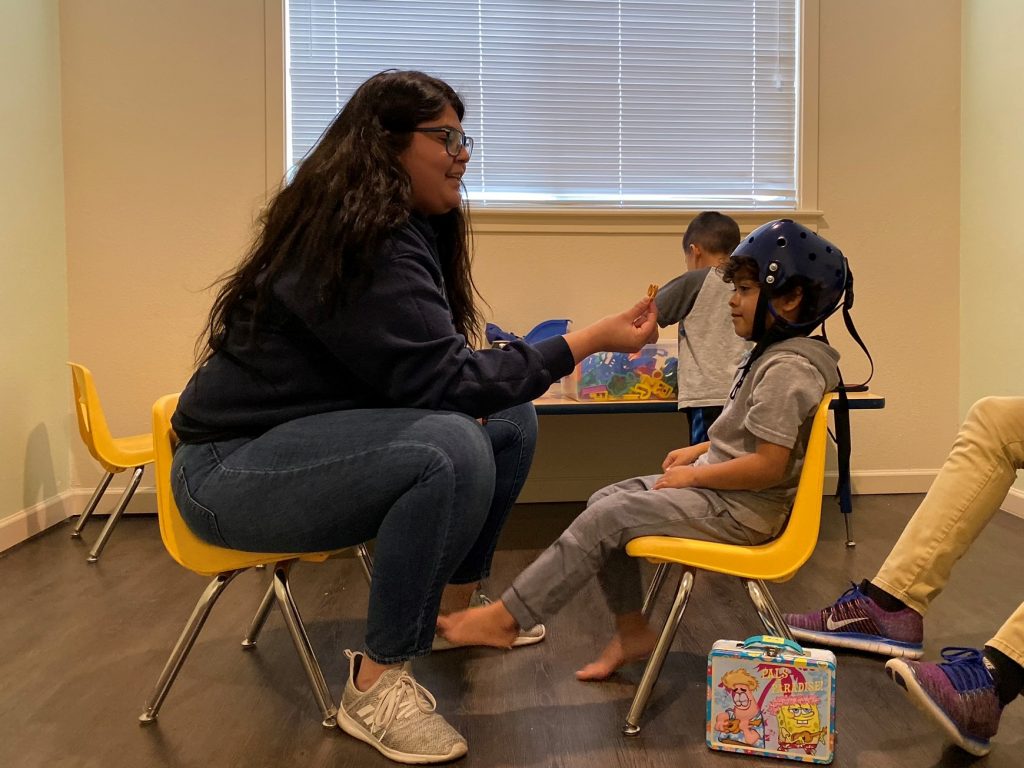Imitation is such an important skill for our learners, especially young learners.
Most people, without realizing it, learn the majority of their skills simply through observation. As a child, your parents, siblings, and friends were models for learning. Your mom or dad may have cooked, cleaned, or done other activities around the house. This improved your understanding of the appropriate way to live in a home. You watched how other kids played on the playground and were able to pick up on what you should do to join in. Through imitation you understood the rules, strategies, and how to play fairly without upsetting the other kids.
Learning Behaviors
For many of our children, learning by observation may not occur naturally. This is why building strong imitation skills is so important.

It is impossible to teach every single skill a person could ever learn, but we can start by teaching “learning behaviors” such as imitating others. Learning behaviors help our kids acquire skills on their own. You’ve heard the old saying “give someone a fish and you feed them for a day. Teach someone to fish and you feed them for a lifetime.” Rather than giving our kids a fish (teaching a specific skill), we want to teach them to fish on their own (provide learning behaviors). By practicing simple imitations, we can generalize this learning behavior to more easily learn many complex and difficult skills.
But how do we go about teaching imitation?
Here are a 6 simple steps that we use to get started:
1. Identify a reinforcer:
In order to motivate your kid to learn imitation, we must control access to a preferred item or food. This can be as simple as a pretzel, their favorite toy car, or even some tickles! Keep this item handy during this exercise. Because preferred items may change, it is important that the item is currently reinforcing to your kiddo!

If you are having a difficult time finding a reinforcing object for your kiddo, it is sometimes helpful to place them in an array like this.
Providing options gives the child the opportunity to choose for themselves. This is one of many preference assessment strategies that can be used.
2. Gain attention:
This one may be tricky, but definitely important.
In order for the next step to be effective, we must have the attention of your child. The attention does not have to be for too long, but just long enough for the direction to be given.

If you are having trouble, the reinforcer may be shown to your kiddo in order to gain their attention!
3. Provide verbal instruction and model to imitate:
Once attention is gained, it’s show time!
First, give a verbal direction to your child to imitate. This may be something simple such as “do this!” or “copy me!” Then provide the model you wish for them to imitate.
Depending on the child’s skill level, the model may be something as simple as raising their hands, or a more complicated activity such as cleaning up.

Verbal models may also be given! First, give a direction to imitate speech such as “say this” or “say….” Then provide the verbal model. Similar to the physical imitation, this may vary from simple sounds (ex. “ahhhh” “mmmm”), single words (ex. “mom” “dad”), or sentences (ex. “I want food” “Give me toy”). Of course, this is depending on the ability of the child.
4. Provide physical prompt (with another person present if possible):
Because we are teaching this new skill, the child will more than likely not know how to respond to the direction. Not to worry! This is where prompting comes in.
Gently physically move the child’s hands to complete the imitation. Ideally, during this exercise we will have a third person available to initiate the prompting. This allows the parent or therapist teaching the imitation to continue modeling the desired action. The child will then be able to see the action to imitate at the same time as being prompted. This reduces the chance of confusion and helps create a better connection between the model and the prompt.


5. Reward!
At this point, your child has just witnessed you make a pose or model and felt themselves prompted to do the same. So how do we tie it all together? Reward it!
Once the child has been prompted to properly imitate an action, give them access to the reinforcer that we identified in step one. Imitation is great and we want your child to think it’s great! So by pairing the action of imitating with their preferred item, we are teaching your child to associate feelings of joy with imitation. In order to make this connection, it is extremely important that the reward is presented IMMEDIATELY after your child performs the appropriate imitation behavior.
6. Do it again!
So you’ve completed steps 1 – 5 with your child. Awesome! Imitation has now been completely mastered and there is no need to ever do it again…
If only, right? Nobody learns by doing things just one time, and like anything else in life, these skills take practice.
But again, as we all know, things are not always as simple as articles on the internet make them out to be. What happens if we follow all of these steps and still see no improvement?
BCBAs at Colorado ABA Therapy are especially trained to handle the challenges of learning. They ensure the proper prompt fading procedure is incorporated. They look out for certain setbacks like prompt dependencies. They can even develop alternative prompt strategies to better accommodate your child’s learning. Every strategy is research based and data backed to support the growth and progress of your child.
Next
time you are with your child, think about what you are teaching and how
imitation plays an important role either directly, or as a foundation skill to
your targets. We encourage every parent to practice these skills with
their child, but if ever there is a bump in the road, feel free to contact your
BCBA for extra help and information!
Questions for your consideration:
1. Is my child able to learn through observation?
2. How can imitation skills be incorporated into my daily routine?
3. What are long term and broad benefits of my child learning imitation skills?

